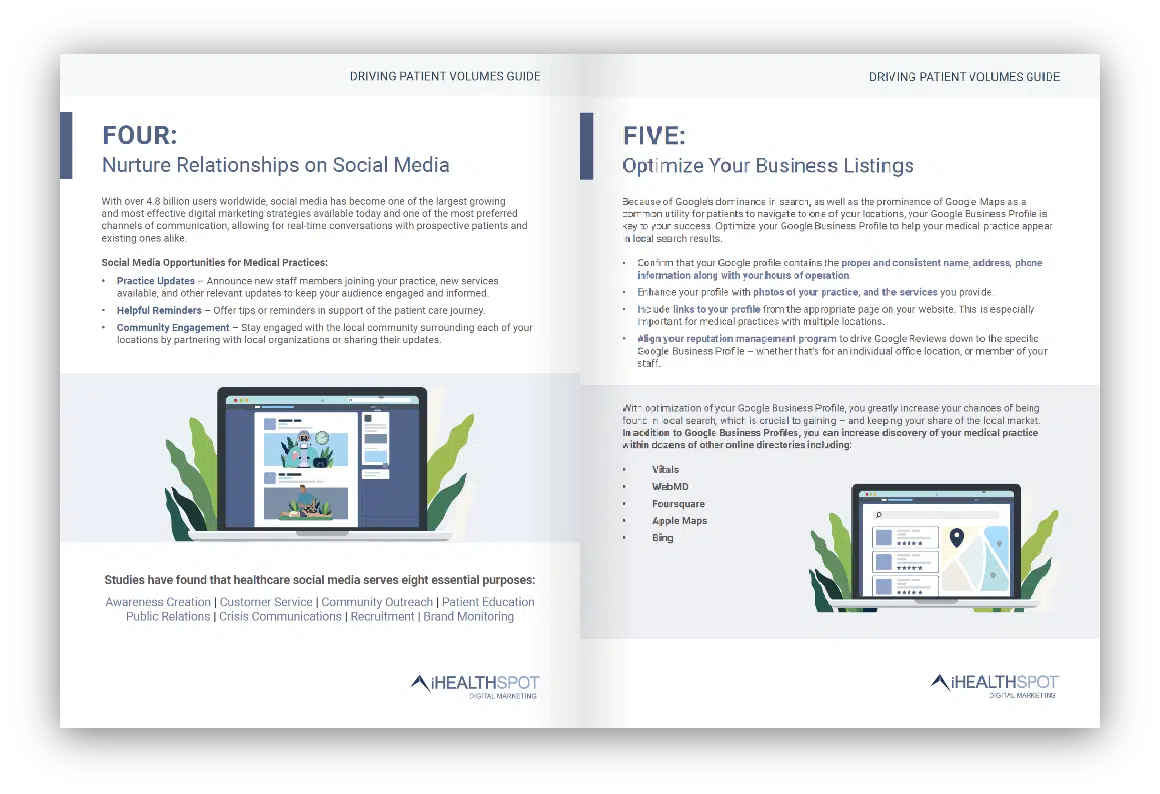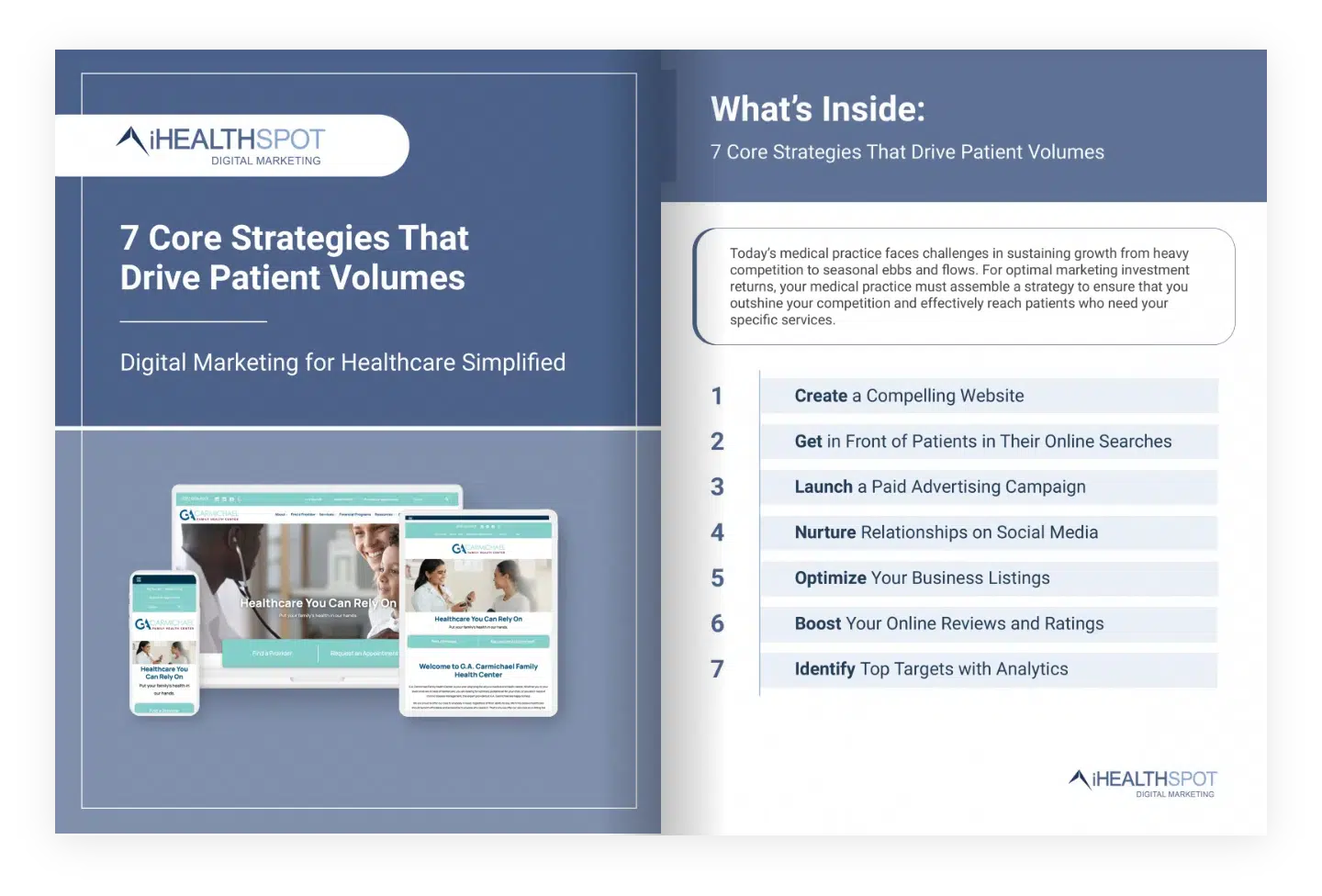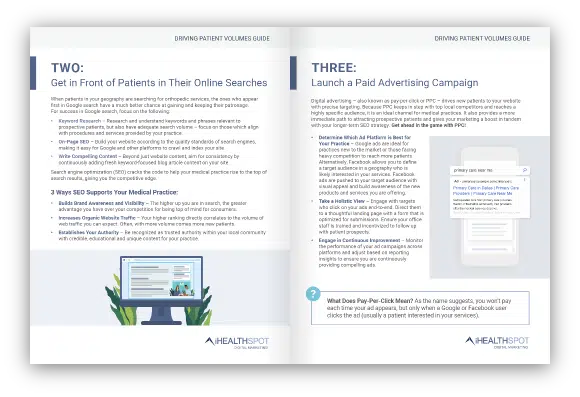DIGITAL MARKETING FOR HEALTHCARE
7 Step Digital Marketing Strategy for Healthcare
When it comes to making the best decisions for your healthcare business – including marketing for healthcare providers – knowledge is power. This downloadable guide for best marketing strategies for healthcare explains each aspect of a complete plan. Read the guide to learn how you can make your digital marketing for healthcare investment more cost-effective by leveraging proven tactics that attract qualified patient leads.


The Best Physician Marketing Strategy Guide for Your Medical Practice
Healthcare consumerism transformed how medical practices connect with patients. This means digital marketing for healthcare is now a core component of a practice growth strategy as providers need greater exposure online when patients are looking for a new provider.
If you have a website, good news! You've already embarked on your digital marketing journey. But if you aren’t getting new patient leads through your website, it is time to find out how to bring more visitors to your website, and how to make your website effective in capturing new patient interest. With a dynamic digital marketing strategy for doctors, you can enhance your current online presence to break growth stagnation.
Download the guide to learn how digital marketing tools fuel medical practice growth.
Get Your Healthcare Marketing Strategy Guide Today
Imagine a day of bass fishing. In your boat, you have sonar to display where bass are swimming, plus multiple fishing poles at your side. By casting all lines, and using bait for luring bass, you’ve put maximum effort into bringing a haul back to shore. This guide will help you navigate the waters of marketing for doctors by covering the benefits of digital marketing for healthcare.
INSIGHTS YOU’LL GAIN THROUGH THIS FREE GUIDE
Learn everything you need to know about marketing your medical practice. Starting with your website and ending with booked appointments, this guide has everything you need to know.
1
What a medical website needs to have for a favorable patient experience that makes a great first impression
2
How to transform your website into a patient traffic magnet through search engine optimization (SEO) and content marketing
3
Paid advertising (pay-per-click, or PPC) equalizes search visibility between your competitors through premium placement
4
Social media’s role in reinforcing your medical practice’s presence online
5
The free tool that is a game changer in local search results: Google Business Profile
6
How patient online reviews are pivotal for the success of your digital marketing strategy
Download Your 7 Step Strategy Guide Now
Find out how to bring more visitors to your website, and how to make your website effective in capturing new patient interest.

Developing an Online Marketing Strategy for Your Medical Practice
Our experience with numerous medical practices informs us of your needs. As a healthcare professional, your focus isn’t business or digital marketing. Our concise guide provides essential marketing insights, helping you develop a smart, effective plan for your clinic.
Downloading this guide offers a quick briefing on key digital marketing strategies for today’s healthcare market, enabling you to make informed decisions. It’s suitable for all medical practices, including small clinics, focusing on essential tactics without the complexity of a full course.
WE’RE YOUR MEDICAL PRACTICE MARKETING AGENCY
iHealthSpot, focusing solely on healthcare businesses across the country, uses its digital marketing expertise to drive growth, patient engagement, and revenue. Catering to clients from small practices to large organizations, we aim to amplify online presence, drawing more patient engagement in the healthcare sector.
Every day, our teams support our:
- Track record of healthcare digital marketing success for specialties
- Award-winning web design, designed to convert patients and promote patient loyalty
- Comprehensive, and data-driven marketing plans based on market intelligence that optimizes campaign performance
- Accountability for results through marketing support and monthly reporting
Download Your 7 Step Strategy Guide Now
Find out how to bring more visitors to your website, and how to make your website effective in capturing new patient interest.

Explore Our Other Resources

Does Your Google Business Profile Help SEO? (It Does!)
Filed Under: Listings management
Search engine optimization (SEO) is one of the digital marketing gears that drives more quality traffic (patients looking for a new provider) to your website. But within SEO there are many moving parts, and Google Business Profiles (formerly known as Google My Business) and Google Maps are a part of what is called local SEO.
Read More
Adding Keywords to Google Business Profile to Boost SEO
Filed Under: Listings management
Google Business Profiles (formerly known as Google My Business) powers local search engine optimization (SEO) by seamlessly integrating an interactive business directory into search results. Visibility in these searches is not a given as businesses must engage digital marketing techniques to get higher rankings in search results such as Google Business Profiles (GBP) optimization. How
Read More
How To Do a Google Business Profile Audit in 7 Steps
Filed Under: Listings management
Local businesses – medical practices included – have an invaluable opportunity to connect with a specific audience through Google Business Profiles (or GBP, formerly known as Google My Business) and Google Maps. This interactive Google search feature appears frequently for consumers actively seeking products and services. With a Google Business Profiles audit, you can ensure
Read MoreFrequently Asked Questions About Healthcare & Medical Marketing
Search engine marketing is a powerful tool for healthcare as it offers targeted reach, expansive visibility, and measurable results. In an increasingly digital world, it's an indispensable strategy component to connect with patients actively seeking healthcare solutions and services.
SEO and PPC work in tandem to ramp up your appearance in search engines so that patients are likely to consider you as a top choice for their healthcare needs.
While there are many ways to market medical practices online, the most potent approach is a comprehensive one. By bundling the best marketing ideas for medical practices, you get the advantage of each digital communications channel to maximize your outreach and connect with patients seeking your services.
By leveraging social media marketing for medical practices, you can engage with a wider audience and establish meaningful connections. Ad platforms like Facebook offer targeted options specifically tailored for healthcare, enabling you to reach the right audience with precision. Through targeted Facebook marketing for healthcare, you can promote your brand.
Whether or not you invest in Facebook ads, consistent Facebook posts allow you to share valuable medical insights, showcase your expertise, and foster a sense of trust among potential patients, ultimately driving growth and success for your practice.
Social media marketing also provides a way to maintain connection with loyal patients between visits. When one of your followers is using social media, and comes across one of your posts, this can be a gentle reminder that they are due back for a visit.
Not all industries are heavily regulated, but healthcare is, and these rules impact digital marketing practices in the medical sphere. First of all, medical practices must ensure that any patient data collected by the website is handled responsibly in adherence to HIPAA policies.
Next, patient reviews must be moderated for any PHI provided. If a patient reveals specific HIPAA protected information, the medical practice should do its due diligence to report the review to the platform managers. What medical practices must also bear in mind is that some keywords for paid ads and the healthcare website itself could be cause for Google to suspend the PPC account, thus halting your digital marketing efforts.
One of the best ways to ensure that your medical practice is conducting digital advertising in a compliant manner is to partner with an agency that fully understands the intricacies of healthcare regulations and policies.
Medical practices typically do not acquire lists of phone numbers and email addresses of everyone in the area, which would be outbound marketing. Inbound marketing strategy for healthcare is when the patients come to you, either through directory listing, paid ads or Google search. With content marketing for doctors, it can take several “touchpoints” with a medical practice before a patient makes the final decision to move forward with an appointment.
Blogs, local SEO for medical marketing, PPC, social media, and Google Business Profiles are all avenues leading to your medical practice website where they can take the first step in becoming a new patient – submitting an appointment request form.
Paid advertising, also known as pay-per-click (PPC) for healthcare, involves placing targeted ads for healthcare services. In paid search marketing for medical practices, you bid on keywords relevant to their services. When patients search for these select terms, these ads appear at the top of search engine results because of paid search marketing for healthcare.
In PPC campaigns, advertisers pay a fee each time their ad is clicked. This directs specific potential to their website or landing page. Digital marketing for healthcare providers is a great way to drive traffic to your website as it maximizes visibility to potential patients who are actively searching for medical services.
Absolutely! Feel free to explore some of our related marketing strategy guides and resources: Marketing For Dentists | Marketing For Dermatology | Marketing For Hospitals | Orthopedic Marketing
Download Your 7 Step Strategy Guide Now
Find out how to bring more visitors to your website, and how to make your website effective in capturing new patient interest.







